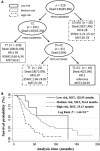Genetic variants in telomere-maintenance genes are associated with ovarian cancer risk and outcome
- PMID: 28233473
- PMCID: PMC5323825
- DOI: 10.1111/jcmm.12995
Genetic variants in telomere-maintenance genes are associated with ovarian cancer risk and outcome
Abstract
Most ovarian cancer patients present at an advanced stage with poor prognosis. Telomeres play a critical role in protecting chromosomes stability. The associations of genetic variants in telomere maintenance genes and ovarian cancer risk and outcome are unclear. We genotyped 137 single nucleotide polymorphisms (SNPs) in telomere-maintenance genes in 417 ovarian cancer cases and 417 matched healthy controls to evaluate their associations with cancer risk, survival and therapeutic response. False discovery rate Q-value was calculated to account for multiple testing. Eleven SNPs from two genes showed nominally significant associations with the risks of ovarian cancer. The most significant SNP was TEP1: rs2228026 with participants carrying at least one variant allele exhibiting a 3.28-fold (95% CI: 1.72-6.29; P < 0.001, Q = 0.028) increased ovarian cancer risk, which remained significant after multiple testing adjusting. There was also suggested evidence for the associations of SNPs with outcome, although none of the associations had a Q < 0.05. Seven SNPs from two genes showed associations with ovarian cancer survival (P < 0.05). The strongest association was found in TNKS gene (rs10093972, hazard ratio = 1.88; 95% CI: 1.20-2.92; P = 0.006, Q = 0.076). Five SNPs from four genes showed suggestive associations with therapeutic response (P < 0.05). In a survival tree analysis, TEP1:rs10143407 was the primary factor contributing to overall survival. Unfavourable genotype analysis showed a cumulative effect of significant SNPs on ovarian cancer risk, survival and therapeutic response. Genetic variations in telomere-maintenance genes may be associated with ovarian cancer risk and outcome.
Keywords: cancer risk; ovarian cancer; single nucleotide polymorphism; survival; telomere maintenance; therapeutic response.
© 2016 The Authors. Journal of Cellular and Molecular Medicine published by John Wiley & Sons Ltd and Foundation for Cellular and Molecular Medicine.
Figures


Similar articles
-
Polymorphisms in telomere-associated genes, breast cancer susceptibility and prognosis.Eur J Cancer. 2009 Nov;45(17):3008-16. doi: 10.1016/j.ejca.2009.08.012. Epub 2009 Sep 18. Eur J Cancer. 2009. PMID: 19766477
-
Genetic variants in the TEP1 gene are associated with prostate cancer risk and recurrence.Prostate Cancer Prostatic Dis. 2015 Dec;18(4):310-6. doi: 10.1038/pcan.2015.27. Epub 2015 Aug 4. Prostate Cancer Prostatic Dis. 2015. PMID: 26238235
-
Genetic variants in matrix metalloproteinase genes as disposition factors for ovarian cancer risk, survival, and clinical outcome.Mol Carcinog. 2015 Jun;54(6):430-9. doi: 10.1002/mc.22111. Epub 2013 Nov 19. Mol Carcinog. 2015. PMID: 25867973 Free PMC article.
-
Rethinking ovarian cancer genomics: where genome-wide association studies stand?Pharmacogenomics. 2017 Nov;18(17):1611-1625. doi: 10.2217/pgs-2017-0108. Epub 2017 Nov 2. Pharmacogenomics. 2017. PMID: 29095100 Review.
-
Role of telomeres and associated maintenance genes in Type 2 Diabetes Mellitus: A review.Diabetes Res Clin Pract. 2016 Dec;122:92-100. doi: 10.1016/j.diabres.2016.10.015. Epub 2016 Oct 21. Diabetes Res Clin Pract. 2016. PMID: 27816684 Review.
Cited by
-
The hallmarks of ovarian cancer: proliferation and cell growth.EJC Suppl. 2020 Aug 22;15:27-37. doi: 10.1016/j.ejcsup.2019.12.001. eCollection 2020 Aug. EJC Suppl. 2020. PMID: 33240440 Free PMC article.
-
Fibronectin 1: A Potential Biomarker for Ovarian Cancer.Dis Markers. 2021 May 22;2021:5561651. doi: 10.1155/2021/5561651. eCollection 2021. Dis Markers. 2021. PMID: 34093898 Free PMC article.
-
PROM1, CXCL8, RUNX1, NAV1 and TP73 genes as independent markers predictive of prognosis or response to treatment in two cohorts of high-grade serous ovarian cancer patients.PLoS One. 2022 Jul 22;17(7):e0271539. doi: 10.1371/journal.pone.0271539. eCollection 2022. PLoS One. 2022. PMID: 35867729 Free PMC article.
-
Telomere Maintenance Variants and Survival after Colorectal Cancer: Smoking- and Sex-Specific Associations.Cancer Epidemiol Biomarkers Prev. 2020 Sep;29(9):1817-1824. doi: 10.1158/1055-9965.EPI-19-1507. Epub 2020 Jun 25. Cancer Epidemiol Biomarkers Prev. 2020. PMID: 32586834 Free PMC article.
-
Molecular Markers of Telomerase Complex for Patients with Pituitary Adenoma.Brain Sci. 2022 Jul 25;12(8):980. doi: 10.3390/brainsci12080980. Brain Sci. 2022. PMID: 35892421 Free PMC article.
References
-
- Siegel RL, Miller KD, Jemal A. Cancer statistics, 2015. CA Cancer J Clin. 2015; 65: 5–29. - PubMed
-
- Evans DG, Gaarenstroom KN, Stirling D, et al Screening for familial ovarian cancer: poor survival of BRCA1/2 related cancers. J Med Genet. 2009; 46: 593–7. - PubMed
-
- Woodward ER, Sleightholme HV, Considine AM, et al Annual surveillance by CA125 and transvaginal ultrasound for ovarian cancer in both high‐risk and population risk women is ineffective. BJOG. 2007; 114: 1500–9. - PubMed
-
- Howlader NA, Krapcho M, Garshell J, et al (eds). SEER Cancer Statistics Review, 1975‐2011. Bethesda, MD: National Cancer Institute; 2014. Available at http://seer.cancer.gov/csr/1975_2011/, based on November 2013 SEER data submission, posted to the SEER web site.
Publication types
MeSH terms
LinkOut - more resources
Full Text Sources
Other Literature Sources
Medical
Research Materials

